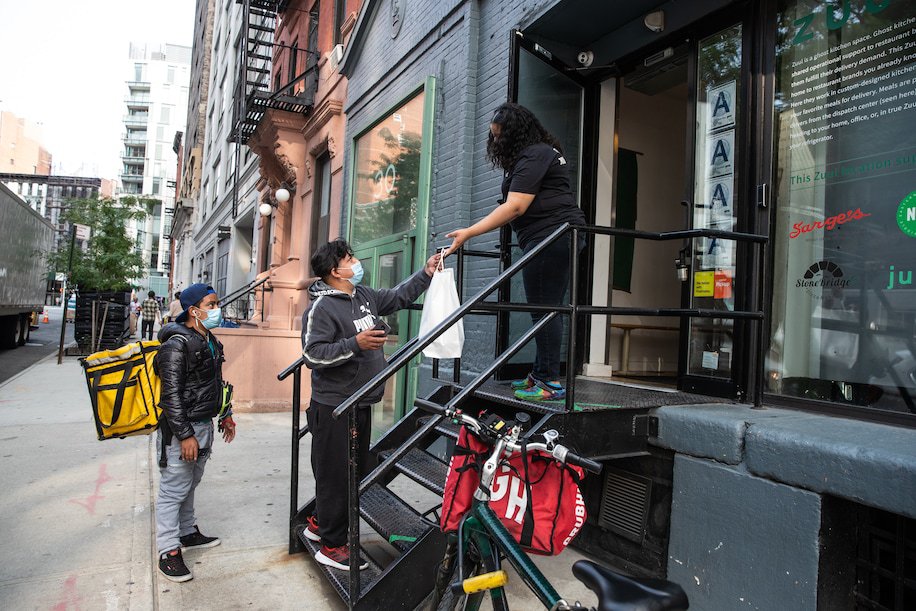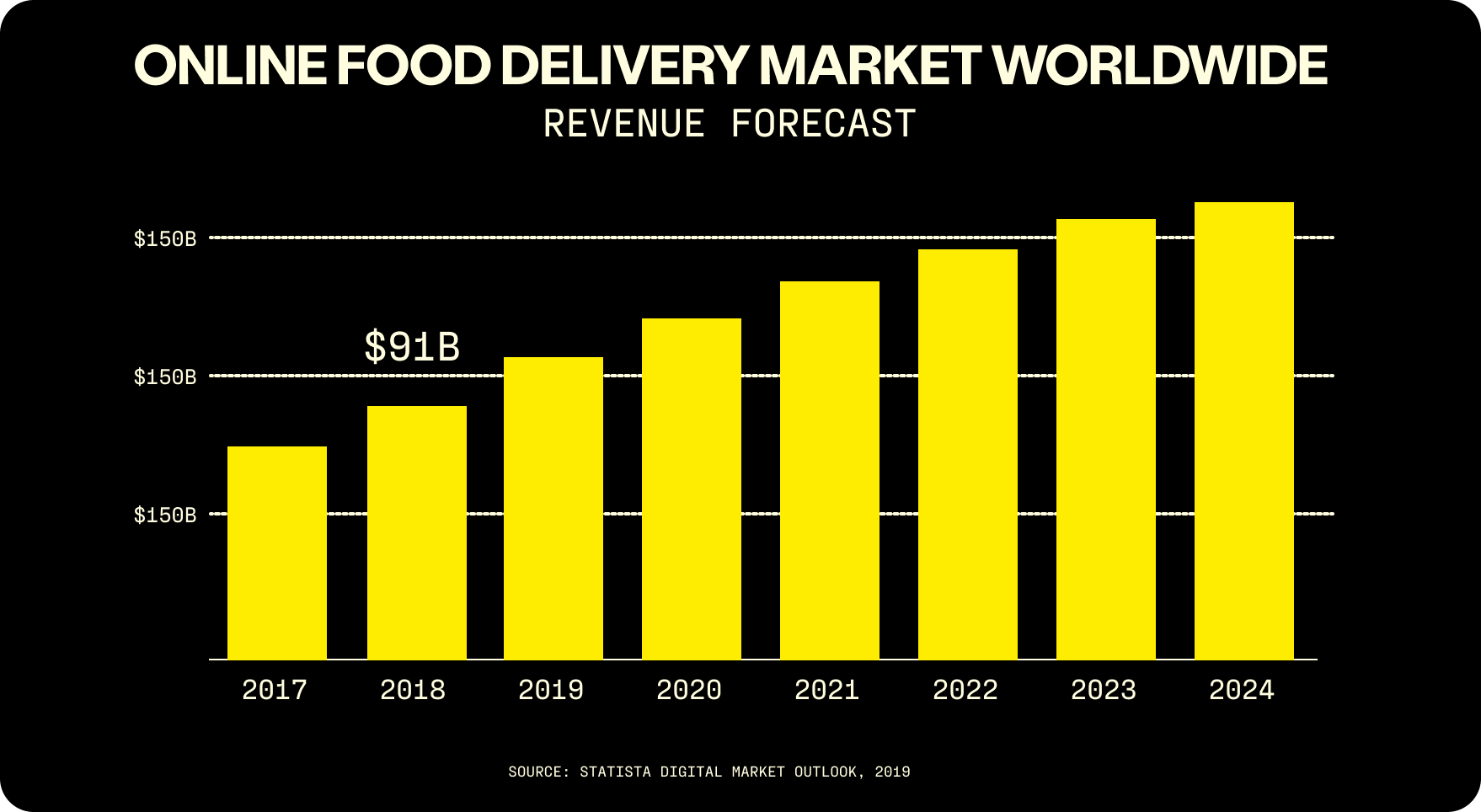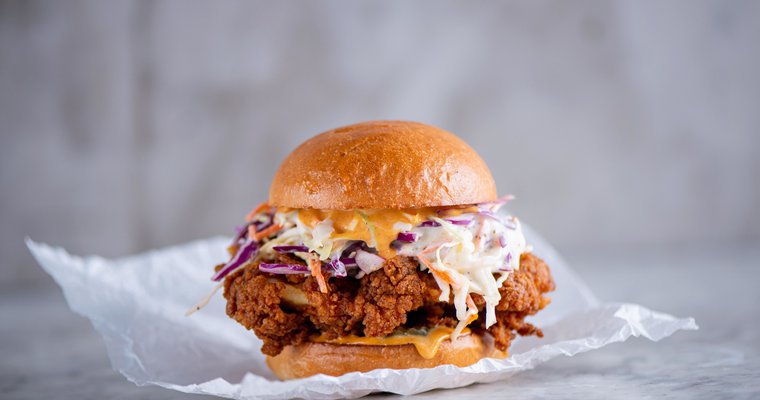Check Out This Guide:
GHOST KITCHEN COMPARISON TOOL: CHOOSE THE RIGHT PROVIDER FOR YOUR VIRTUAL RESTAURANT
Ghost Kitchens
OCT 22, 2021
Share
The dream of launching a new restaurant in today’s climate is daunting, no doubt. While the romance of diners gathering together in your concept might be a little bleak, there are still options to having your own restaurant. The dream isn’t dead. The virtual kitchen concept has revolutionized the restaurant industry by eliminating one of the major components for any restaurant: the dine-in area. Experts expect the food delivery market to be worth $365 billion by 2030, a tenfold increase over today.
Wondering "what is a virtual kitchen?" A virtual kitchen, also commonly known as a ghost kitchen, is a restaurant that eliminates the eat-in option for diners and focuses purely on off-premise sales channels. Under a virtual kitchen concept, a virtual kitchen operates as delivery only, with some offering takeout options. While they’re able to cut costs like real estate and labor, the process for the customer is essentially the same as it would be for ordering from any restaurant. Customers contact the business through the restaurant’s website, app or phone, or a third-party delivery app.

Delivery workers pick up food outside Zuul. Image Source: The Washington Post
The rise of virtual brands is right on trend with the rising popularity of delivery. A continually shifting consumer base and high competition have always driven the sector to pursue new ways of doing business. Global food delivery accounted for more than $120 billion dollars in revenue this year alone. By 2024 that number is expected to reach $164 billion dollars.

Since the COVID-19 pandemic hit, the restaurant industry has had to adapt. According to the National Restaurant Association (NRA), nearly one in six restaurants (that’s about 100,000 restaurants) closed either permanently or long-term at the start of the pandemic. The industry lost about $240 billion in sales by the end of 2020.
Although the restrictions on restaurants are starting to lift, COVID-19 has permanently impacted the future of restaurants. As restaurateurs struggle to find ways to succeed in the new dining landscape, consumer behavior has also radically shifted. Stay-at-home orders and dining restrictions prompted restaurants to adapt and put more focus on takeout and delivery. These same conditions have afforded virtual kitchen concepts a chance to shine.
As delivery rises in popularity, it also becomes a consumer expectation. The NRA also reported that in 2021, 53% of adults report that purchasing takeout or delivery food is essential to the way they live. That’s a lot of takeout. And that’s money to be made if you’re a restaurant owner. To keep up with this rise in takeaway demand, restaurants need to get on the delivery train to avoid missing out on a huge customer base.
Also according to the NRA’s report, a year after the pandemic started, 60% of adults say they’re more likely to get their food delivered than they were before the outbreak. For millennials, it’s 71%. As restaurants adapt to how customer dining preferences have changed, virtual kitchens are now more popular and quite often more profitable. If you’re considering the idea of a virtual kitchen for your restaurant group, you need to understand what goes into it.

Image source: The Spoon
The possibilities for a successful restaurant business model have evolved. Even before COVID-19, the food delivery services industry was expected to grow from $43 billion in 2017 to $467 billion in 2025 – now it's expected to be $1 trillion by 2030. In fact, it’s actually one of the only areas in the restaurant industry seeing growth right now.
Running a full-scale restaurant requires capital. There are costs you have to consider for every decision you make. And one of the major costs incurred is rent. With real estate prices soaring, being able to afford rent in a trendy or lively neighborhood feels like an unattainable goal for many – including restaurant operators. Renting and running a unit with a kitchen only and no guest dining area immediately cuts costs. In a typical restaurant, you would need a front-of-house team for your dining room. But with a ghost kitchen, you only need some back-of-house members. You also spend less on the dine-in experience like furniture, lighting, and decor. When it comes to the location, all you need to focus on is being in an area that makes easy delivery to where your target audience is situated. With lower real estate and labor costs, our bills are significantly lowered.
You wouldn’t just have a lower need for capital with a virtual kitchen, but you can even look into ditching a landlord. Unlike traditional landlords, some virtual kitchens provide valuable, hands-on assistance to get you up and running and help you build and maintain momentum. For example, Kitchen United offers brands not only a commercial kitchen space but also other resources and business intelligence for them to succeed. As a virtual kitchen, you have new operating models now available to you as a tenant.
With a ghost kitchen, you’ll be able to reach more customers than ever before, from one single kitchen. You’ll ideally be located within a delivery hotspot, so you can reach a higher volume of customers at a fraction of the cost. This means you can expand your reach without ever having to open another brick-and-mortar location. Let’s say you own a fast-casual burger franchise where the bulk of your business is locals dining inside your brick-and-mortar location. If you expand with a ghost kitchen, you’ll be reaching a whole new set of customers online, in addition to your dine-in regulars.
Check Out This Guide:
GHOST KITCHEN COMPARISON TOOL: CHOOSE THE RIGHT PROVIDER FOR YOUR VIRTUAL RESTAURANT
You may have been wondering how to expand your menu or your restaurant itself, but are concerned with the time and costs that come along with it. As a virtual restaurant brand, you can quickly expand to new markets and cut the costs you’d have with a full-service restaurant. Within weeks you can launch in new regions and determine which will be the most successful, without making a large investment.
According to the Bureau of Labor Statistics, about 20% of small businesses fail in their first year and about 50% in their fifth year. That figure could actually be greater for high-competition industries like restaurants. Poor location and misunderstanding of the local market are common reasons behind these closures. To avoid these pitfalls, restaurant owners can open a less expensive virtual kitchen to get to know an area. Since ghost kitchens cost so much less to operate, they’re less risky to open. Expanding businesses can use them to see how a market could respond to a new type of establishment or food before investing in a full restaurant. If it proves a success, restaurants can either keep the expansion as a virtual kitchen or grow it into a more traditional establishment.
When it comes to marketing and sales for a virtual kitchen, your online presence needs to be strong and effective. Reaching out to your customers on the platforms they frequent goes a long way. You’ll want to focus on driving brand awareness, actual orders, and five-star reviews. To run a successful virtual kitchen, you need to effectively market your restaurant online. This means everything from marketing within each digital platform like online, your delivery app, across social media, paid advertising, and email.
The pandemic forced consumers to hone their tech skills to master online ordering, electronic payment, and order pick up when the industry shifted digitally. As of 2019, Millennials have surpassed Baby Boomers as the largest generation in the U.S. Millennials grew up with the internet, meaning the most substantial market segment is digitally savvy. When it comes to digital engagement, what was once a nice-to-have is now a necessity. As a virtual kitchen, you tap into this growing demand for delivery and online ordering.

C3’s virtual kitchen concept, Sam's Crispy Chicken. Image source: Fast Casual
Here are some examples of virtual kitchens in the market.
C3 (Creating Culinary Communities) by SBE is a hybrid digital kitchen and food hall platform, powering a portfolio of well-known brands like Krispy Rice, Umami Burger, and Sam's Crispy Chicken. Partnering with Lunchbox, the app lets shoppers order from more than 200 ghost kitchens and brick-and-mortar restaurants in one place for the first time ever.
Based in Bucharest, Virtual Food Courts houses food brands, develops menus, cooks in their commercial kitchen, and then has them delivered. Their mission is to produce a wide range of high-quality dishes, which can be received within 30 minutes of ordering. The current brands are: Burger Mission, Poke Breeze, and Ultima Felie.
CloudKitchens is a startup that rents commercial space and provides smart kitchens for delivery-only restaurants. It’s launched by Uber co-founder and former CEO Travis Kalanick. They provide infrastructure and software that enables ghost kitchen brands to open delivery-only locations with minimal capital expenditure and time.
Kitchen United offers commercial kitchen space, business intelligence, and resources for ghost kitchens to succeed. They offer restaurants a food production facility combined with insights and ideas on how to profitably expand into the food delivery business. They are known for their ‘multi-restaurant ordering’ — the ability to deliver foods from multiple restaurants in one delivery order
REEF transforms urban spaces into neighborhood hubs that connect people to locally curated goods, services, and experiences. REEF is the largest operator of mobility, logistics hubs, and neighborhood kitchens in the United States, Canada, and has a growing presence in Europe. REEF’s Neighborhood Kitchens enable restaurants to expand by providing turnkey delivery solutions for the preparation, distribution, and expansion of food concepts.
Zuul is a ghost kitchen concept that provides shared kitchens in their ghost kitchen facilities. They offer food delivery programs and strategic consulting to those looking to launch in the ghost kitchen or food delivery space.
Kitopi is the world’s leading cloud kitchen platform with its roots in Dubai. Kitopi enables restaurants to open delivery-only locations by providing the necessary infrastructure and software. They also take care of the entire customer experience journey: receiving and processing orders, cooking, delivery operations, and managing customer feedback. They have over 1000 employees across UAE, KSA, and Kuwait.
Tomlinson Brands is an engineering and technology company that produces, packages, and delivers gourmet food recipes by different brands. They are one building, one kitchen, but multiple restaurant concepts. They are committed to being a technology leader and have the systems in place to manage the inflow and outflow required to run multiple concepts from a single building.
The restaurant industry has been reimagined and virtual kitchens are at the forefront. Now is the time to capitalize on this market opportunity that’s only expanding. If having a restaurant is a goal you’ve been working towards or a life dream, virtual restaurants or virtual kitchens could be an opportunity to explore.
Interested in learning more about Lunchbox for Virtual Restaurants?
See how Lunchbox can help simplify your ghost kitchen operations.
ENTER YOUR EMAIL TO STAY IN THE KNOW!